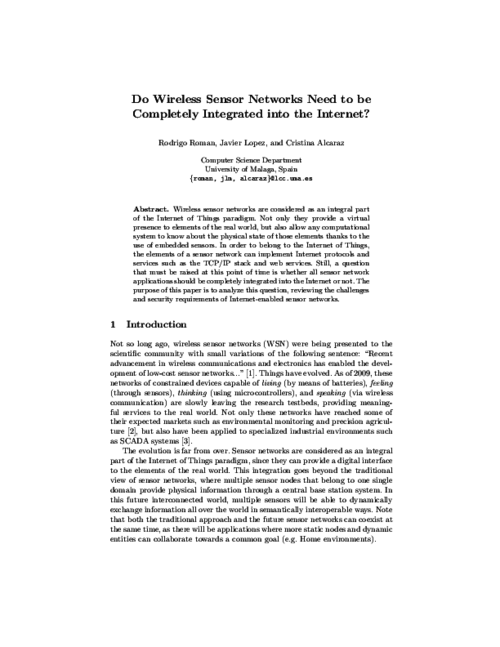CRISIS
Interconnected Sensor Networks for Critical Information Infrastructure ProtectionFunded by Spain Ministry of Industry (TIN2006-09242) |
CRISIS is mainly focused on the design of security solutions for Critical Information Infrastructures (CIIs) by means of the development of protection, control and evaluation mechanisms. These solutions use Wireless Sensor Networks (WSNs) [1] as a main technological platform because that technology facilitates a distributed control and allow the different components of the network to remain operative, even in crisis situations [2][3][4].
In order to guarantee the faultless interoperability of the protection, control and evaluation mechanisms, new security services had to be created and integrated into a Service-Oriented Architecture. This Architecture was specifically devised for Critical Infrastructures (and in particular for SCADA systems [5][6]) using a trust management model, which was also designed for this purpose.
Finally, the Architecture was validated and verified in different ways. On one hand, we designed and developed management and maintenance systems embedded into the Architecture, such as Early Warning [7][8], Dynamic Reconfiguration and Auditing Systems. On the other hand, with the aim of providing support for the infrastructure, some tools for decision support and risk assessment were also provided [9]. Lastly, an integration analysis of WSNs into the Internet and a security analysis were carried out. The idea were to study the feasibility of using the WSN technology in different critical scenarios, such as First Responders and SCADA systems [10].
References
-
"Analysis of Security Threats, Requirements, Technologies and Standards in Wireless Sensor Networks",
Foundations of Security Analysis and Design 2009, LNCS 5705, Springer Berlin/Heidelberg, pp. 289-338, August, 2009. DOI
 More..
More..Abstract
As sensor networks are more and more being implemented in real world settings, it is necessary to analyze how the different requirements of these real-world applications can influence the security mechanisms. This paper offers both an overview and an analysis of the relationship between the different security threats, requirements, applications, and security technologies. Besides, it also overviews some of the existing sensor network standards, analyzing their security mechanisms.
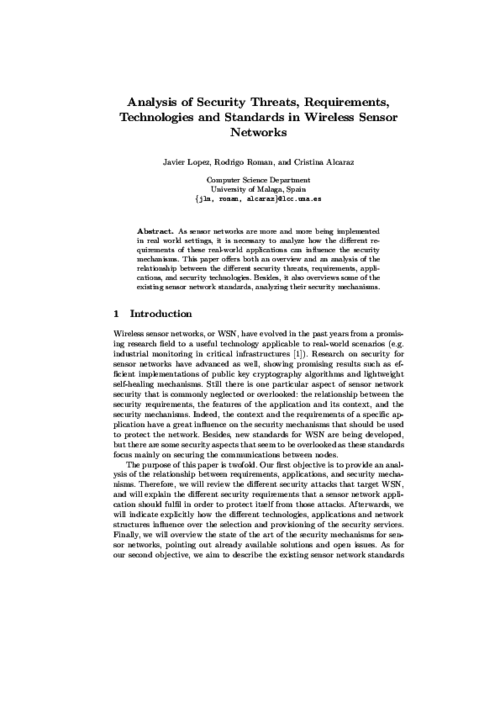
-
"Applying Key Infrastructures for Sensor Networks in {CIP/CIIP} Scenarios",
1st International Workshop on Critical Information Infrastructures Security (CRITIS’06), LNCS 4347, Springer Berlin / Heidelberg, pp. 166-178, 2006. DOI
 More..
More..Abstract
It is commonly agreed that Wireless Sensor Networks (WSN) is one of the technologies that better fulfills features like the ones required by Critical (Information) Infrastructures. However, a sensor network is highly vulnerable against any external or internal attacks, thus network designers must know which are the tools that they can use in order to avoid such problems. In this paper we describe in detail a procedure (the KMS Guidelines), developed under our CRISIS project, that allows network designers to choose a certain Key Management System, or at least to know which protocol need to improve in order to satisfy the network requirements.
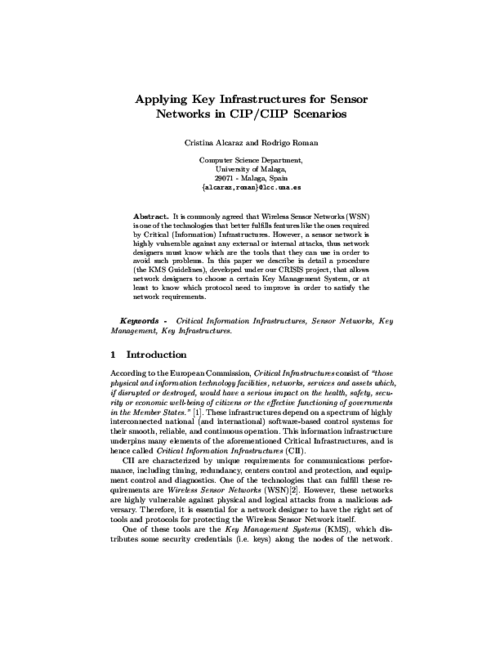
-
"On the Protection and Technologies of Critical Information Infrastructures.",
On Foundations of Security Analysis and Design IV, FOSAD 2006/2007, Springer, LNCS 4677, pp. 160-182, 2007. DOI
 More..
More..Abstract
Critical Infrastructures are complex and highly interconnected systems that are crucial for the well-being of the society. Any type of failure can cause significant damage, affecting one or more sectors due to their inherent interdependency. Not only the infrastructures are critical, but also the information infrastructures that manage, control and supervise them. Due to the seriousness of the consequences, the protection of these critical (information) infrastructures must have the highest priority. It is the purpose of this book chapter to review and discuss about these infrastructures, to explain their elements, and to highlight their research and development issues. This chapter will also discuss the role of Wireless Sensor Network (WSN) technology in the protection of these infrastructures.
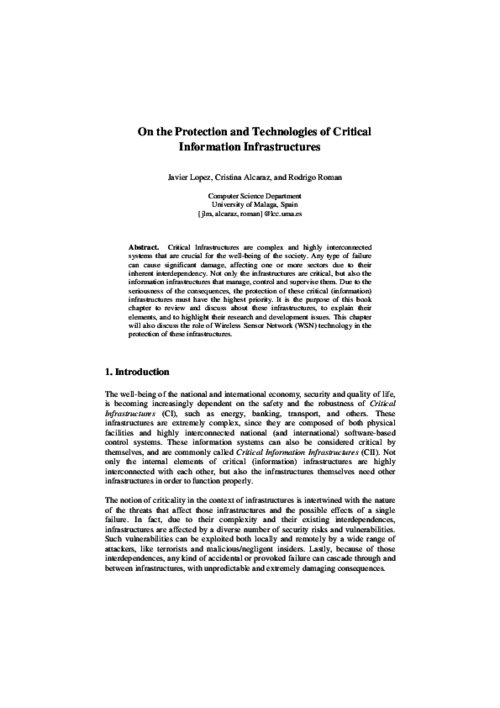
-
"The Role of Wireless Sensor Networks in the Area of Critical Information Infrastructure",
Information Security Technical Report, vol. 12, no. 1, Elsevier, pp. 24-31, 2007. DOI
 More..
More..Abstract
Critical Infrastructures, such as energy, banking, and transport, are an essential pillar to the well-being of the national and international economy, security and quality of life. These infrastructures are dependent on a spectrum of highly interconnected information infrastructures for their smooth, reliable and continuous operation. The field of protecting such Critical Information Infrastructures, or CIIP, faces numerous challenges, such as managing the secure interaction between peers, assuring the resilience and robustness of the overall system, and deploying warning and alert systems, amongst others. In this tapestry of CIIP, Wireless Sensor Networks can be used as an invaluable tool due to their intelligent distributed control capabilities, alongside with their capability to work under severe conditions. In this paper, we justify why Wireless Sensor Networks technology is suitable for providing security for these scenarios, describing both their advantages and research issues and their role in the overall scheme of protecting the Critical Information Infrastructures.
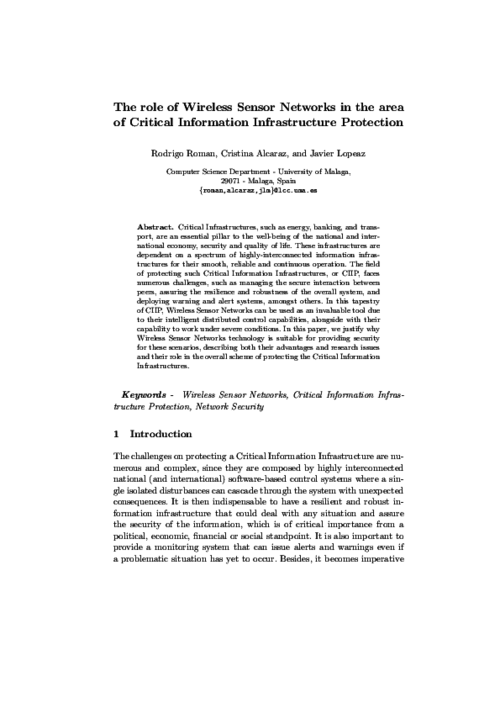
-
"Gestión segura de redes SCADA",
Nuevas tendencias en gestión de redes, Novática, no. 196, CEPIS, pp. 20-25, December, 2008.
 More..
More..Abstract
En el momento que se introduce en el mercado nuevas tecnologías basadas en entornos distribuidos comienzan a surgir en paralelo nuevos problemas de seguridad en los sistemas SCADA (Supervisory Control and Data Acquisition), los cuales monitorizan y gestionan otras infraestructuras de gran complejidad y escala. Un fallo o una interrupción en uno de sus componentes podría suponer un impacto negativo sobre la funcionalidad de otras infraestructuras, por lo que se hace necesario realizar frecuentes análisis de seguridad para así mantener actualizado el conocimiento y proveer recomendaciones y/o soluciones para mitigar o evitar futuras ocurrencias, garantizando una gestión de red fiable y siempre disponible.
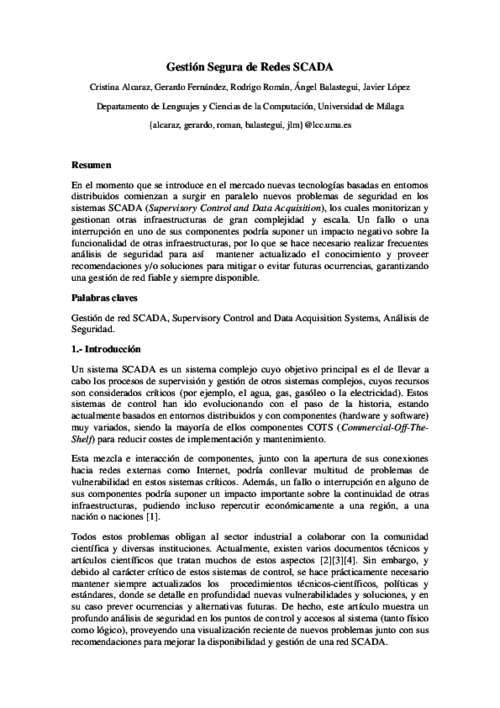
-
"Secure Management of SCADA Networks",
Novatica, New Trends in Network Management, vol. 9, no. 6, Cepis UPGRADE, pp. 22-28, December, 2008.
 More..
More..Abstract
When a Supervisory Control and Data Acquisition (SCADA) system monitors and manages other complex infrastructures through the use of distributed technologies, it becomes a critical infrastructure by itself: A failure or disruption in any of its components could implicate a serious impact on the performance of the other infrastructures. The connection with other systems makes a SCADA system more vulnerable against attacks, generating new security problems. As a result, it is essential to perform diverse security analysis frequently in order to keep an updated knowledge and to provide recommendations and/or solutions to mitigate or avoid anomalous events. This will facilitate the existence of a suitable, reliable, and available control network.
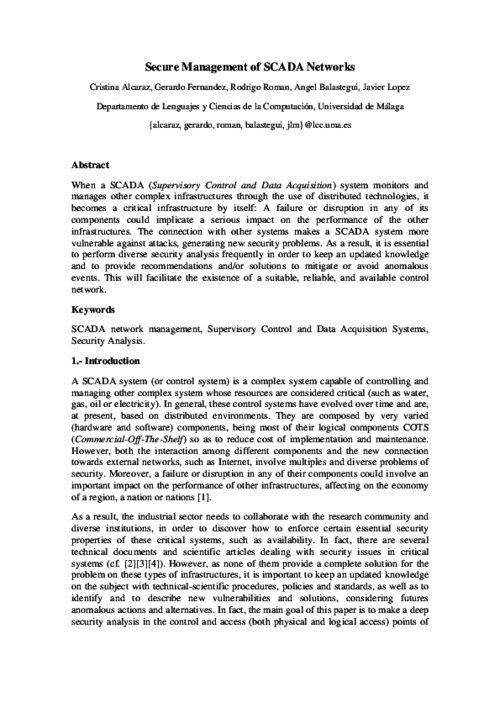
- Citekey Lopez2010a not found
- Citekey Alcaraz2009a not found
-
"Adaptive Dispatching of Incidences Based on Reputation for SCADA Systems",
6th International Conference on Trust, Privacy and Security in Digital Business (TrustBus’09), Springer-Verlag, pp. 86-94, September, 2009. DOI
 More..
More..Abstract
SCADA systems represent a challenging scenario where the management of critical alarms is crucial. Their response to these alarms should be efficient and fast in order to mitigate or contain undesired effects. This work presents a mechanism, the Adaptive Assignment Manager (AAM) that will aid to react to incidences in a more efficient way by dynamically assigning alarms to the most suitable human operator. The mechanism uses various inputs for identifying the operators such as their availability, workload and reputation. In fact, we also define a reputation component that stores the reputation of the human operators and uses feedback from past experiences.
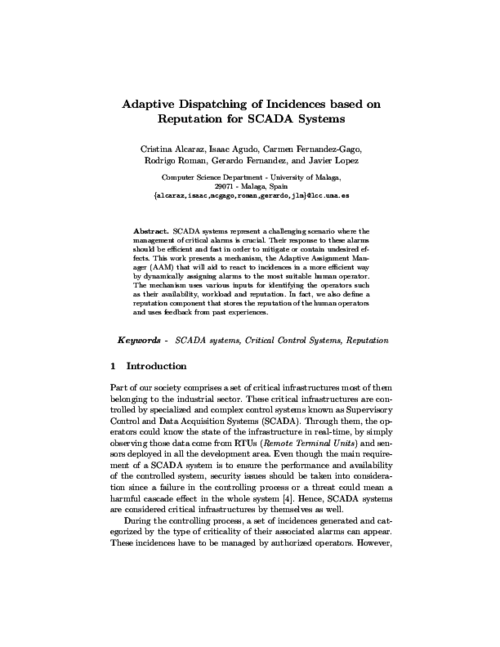
-
"Do Wireless Sensor Networks Need to be Completely Integrated into the Internet?",
3rd CompanionAble Workshop - Future Internet of People, Things and Services (IoPTS) eco-Systems, xxxx, pp. xxxx, December, 2009.
 More..
More..Abstract
Wireless sensor networks are considered as an integral part of the Internet of Things paradigm. Not only they provide a virtual presence to elements of the real world, but also allow any computationalsystem to know about the physical state of those elements thanks to the use of embedded sensors. In order to belong to the Internet of Things, the elements of a sensor network can implement Internet protocols and services such as the TCP/IP stack and web services. Still, a question that must be raised at this point of time is whether all sensor network applications should be completely integrated into the Internet or not. The purpose of this paper is to analyze this question, reviewing the challenges and security requirements of Internet-enabled sensor networks.
